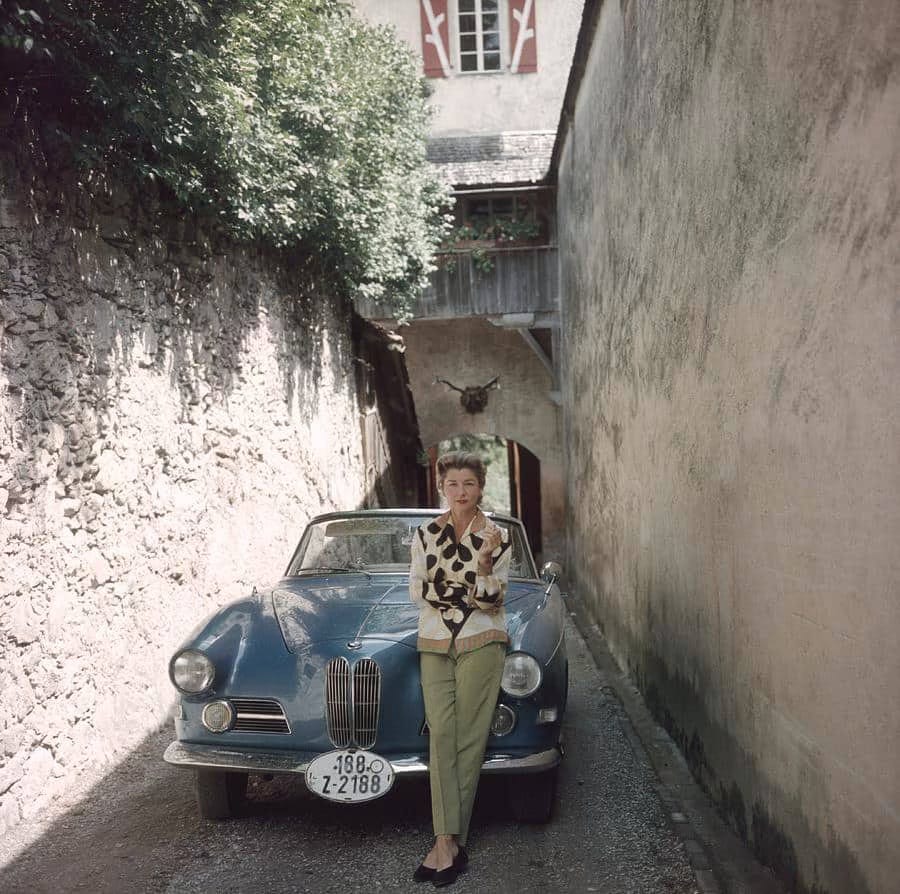Honeychile was an unusual doll. You rarely find a girl who’s pretty and funny at the same time. Usually if a girl is funny, it’s because she is unattractive and being witty is a way of attracting attention. But Honeychile was naturally funny. […] She must have had chameleon blood.”
— Bob Hope

Patricia Anne zu Hohenlohe-Waldenburg-Schillingsfürst (née Patricia Wilder) started as an actress in Broadway and Hollywood in the 30s, became a famous socialite in New York and the inspiration for Truman Capote’s Holly Golightly in the 40s, and Ian Fleming’s Honeychile Rider in Dr. No in the 50s.
Later in life she married Prince Alexander Hohenloe and relocated with him to Austria and, after he died, to Marbella.
Table of Contents: Origins / New York City / Hollywood / Halcyon Days / Truman Capote / WWII & South America / Egypt / King Farouk / Alexander Hohenlohe / Ian Fleming / Marbella / Later years / Did you know?
This is the first of a two-part, 3000-word long, Adorable Story: to make the reading easier and more manageable, subscribers will receive the second part of this Adorable Story next weekend.
With warmest regards from Italy,
— Alberto
If you aren’t subscribed yet, hit the subscribe button below to receive the Adorable Stories every weekend, directly in your inbox:
Origins
Patricia “Honeychile” Wilder was born in Macon, Georgia on September 8th, 1913 (although she claimed all her life to be born in 1918) to Oscar Owen Wilder and Laura Bryant Wilder. She was part of a large, humble family and had 12 brothers and sisters.
While still a teenager she decided to leave Georgia, and move up north. From the moment she arrived in the mid-1930s in New York she took the city by storm.
New York City
Within a day of her arrival in New York, Patricia — after a fortuitous encounter in the office of talent agent Louis Schurr — was hired as a showgirl and was soon appearing with Bob Hope at the Palace Theater.
In his own words, Bob Hope described Patricia as follows:
“she had a spoon bread Southern accent. I was looking for a different personality and when she said “Ha you, Mistah Hope?” I knew I had one. I took her on a couple of tryout shows. I was worried about the possibility of her having stage fright – until she walked out before her first Capitol audience and said, “Pardon me, Mistah Hope. Does the Greyhound bus stop heah?” then instead of looking at me, she looked at the audience and smiled. I knew then that Honeychile had been born unembarrassed. In fact, she had so much poise I began to worry about whether anyone would notice me on the stage”
It was during this stint that Patricia Wilder played the role of “Honeychile” in Bob Hope’s show, and the character was billed as the girl with the Southern drawl and the numbed brain.
Little did she know that she would keep this nickname for the rest of her life.
Hollywood
Not long afterwards, Patricia left New York City and made her way to Hollywood to pursue a career in acting.
After a screen test, RKO signed her up with a contract.
While in Hollywood, Patricia remained in close contact with Bob Hope, continuing to work with him on his radio shows during her entire career, and she also had a film role alongside him in the 1936 film Walking on Air.
Reflecting on her early days in Hollywood, Bob Hope wrote:
“Her first morning in Hollywood, she rented an apartment, paid a one hundred dollar deposit and reported to the studio. At the end of the day she couldn’t remember where the apartment was. She never did remember. She just found another one.
It was also during her first day in Hollywood that she waited a long time to see the head of RKO, Sam Briskin. When she was finally admitted to his office, she said, “I’ve been waiting to see you for two hours. Who do you think you are, Darryl Zanuck?”
She received her first Hollywood role in 1936: a minor part alongside James Stewart in the movie Speed.
1936 was a busy year: Patricia had a credited role as “Babe,” alongside Gloria Stewart and Lee Tracy in Wanted: Jane Turner. Additionally, she also starred in So and Sew.
Slowing down the next years, she had minor role appearances in 1937 and 1938.
Disenchanted and dissatisfied with the path of her career, Patricia retired from acting after 1938 by choice.
While acting in Hollywood, Patricia had romances with Clarke Gable and Tyrone Power (extensively featured in the Adorable Story #33), but she left both of them for her horseback riding teacher.
Although she was never really considered a “star” by Hollywood standards, she soon became quite famous as a socialite in New York.
It was around this time that Patricia started to settle into the role that would come to define her: starting off as the femme fatale and eventually becoming a celebrated international hostess.
There was hardly a night the slender beauty with the Southern accent couldn’t be found at the Colony or the Monte Carlo for dinner, followed by stops at the Stork Club, the Cafe Pierre and El Morocco.
She had lunch at Club 21 so often that the bartender created a Honeychile drink in her honor: a whiskey sour made with honey rather than sugar.
Halcyon Days
As she would later recall, those were the years when she lived life to the fullest: Conde Nast would send his limousine to take her to black-tie dinners at his town house; George Gershwin asked her to sit next to him at the piano while he was composing Porgy and Bess, and she used to go bar-hopping with Walter Winchell and his friend J. Edgar Hoover.
Patricia had a particular affinity for millionaires, a circumstance which would not have raised problems if their wives had been a bit more understanding.
One wife who apparently was not willing to look the other way was Beverly Paterno (her husband Joe Paterno, a personal friend to Charles “Lucky” Luciano, was the heir to a real estate fortune, at the time calculated in 63 million in 1941 dollars — approx. 1.3bn in today’s value).
The two women met at the Cafe Pierre on the night of February 22nd, 1941: the content of their verbal exchange was not recorded, but Honeychile’s response to Beverly accusations made headlines the next day: she punched her rival with a flurry of rights and lefts, then hit her with a pitcher of water.
Truman Capote
“Everybody was my friend, but I wasn’t in love with nobody.”
— Honeychile Wilder
Capote drew from various socialites and his own experiences to create the character of Holly Golightly in Breakfast at Tiffany’s, but it is widely accepted that Honeychile Wilder was his main inspiration for the female protagonist of his famous novel.
WWII & South America
Time Magazine reported on August 11th, 1941:
“Cafe society’s Patricia Anne (“Honeychile”) Wilder went bankrupt for $8,212.24—mostly clothes and a $600 phone bill.”
However, even in this difficult (financial) situation, she somehow found the time (and money) to meet with John F. Kennedy in the bomb shelters of World War II London.
Having been married before to Robin “Curly” Harris, after the World War II ended she found a second husband named Alberto Cernadas, a beef baron and Argentinian millionaire.
Cernadas owned many beautiful mansions across the continent and upon hearing that Bob Hope was traveling to South America, Honeychile offered up one of their residences for him to stay in while visiting around.
According to Bob Hope:
“When we reached Montevideo and I got off the plane, I said to the local Paramount representative who met us, “Where am I going to stay? I’d like to check into the best hotel.” “You’ve been taken care of,” he said. Apparently, Honeychile had arranged for me to stay at her place.”
“I did not know what kind of place it was, so I asked the Paramount man, “Do you think we ought to go?” “Yes” he said. “I think you ought to go.”
“When we got there, we found that it was one of the country’s show places. We had it to ourselves. If we thought of something that we wanted an arm came through the wall and gave it to us. The estate was equipped with a big swimming pool, a private zoo and a private theater.”
Egypt
After becoming the “Playgirl of the International Set,” Honeychile traveled to Egypt in 1949 with her husband Cernadas, who was busy on a polo tournament.
Traveling along with her was a glamorous group that included the tobacco heiress Doris Duke and her then husband, legendary Dominican diplomat and playboy Porfirio Rubirosa.
With most of Europe still in postwar ruin, Egypt was the place for the international crowd to bask under the sun.
In fact, Egypt was at the time at the peak of its glamour, since it was the last real kingdom where royalty proceeded unabashed: no royal was less abashed than King Farouk.
(Continues to Part 2…)
—Alberto @
Do you know anyone who would love to read this Adorable Story? Show your support by sharing Adorable Times’ Newsletter and earn rewards for your referrals.









